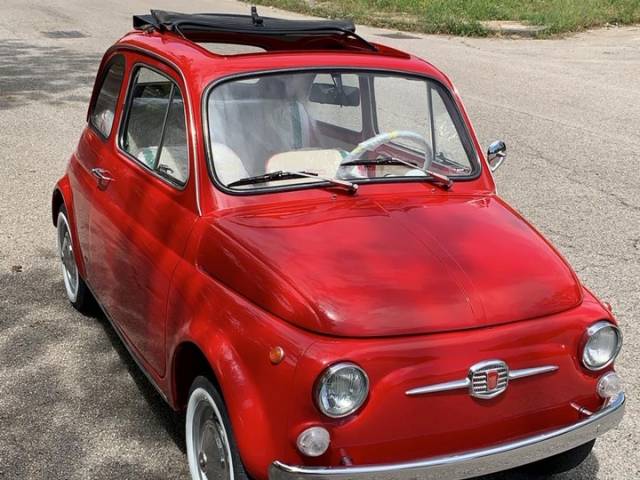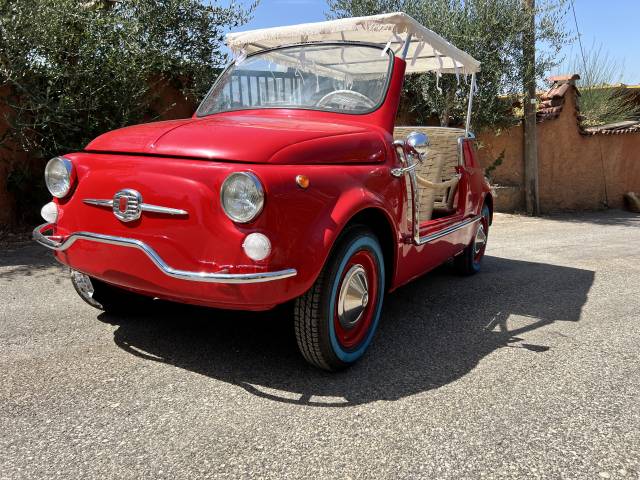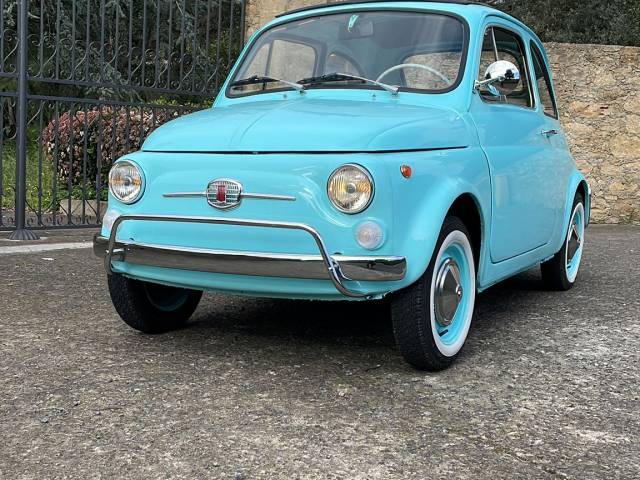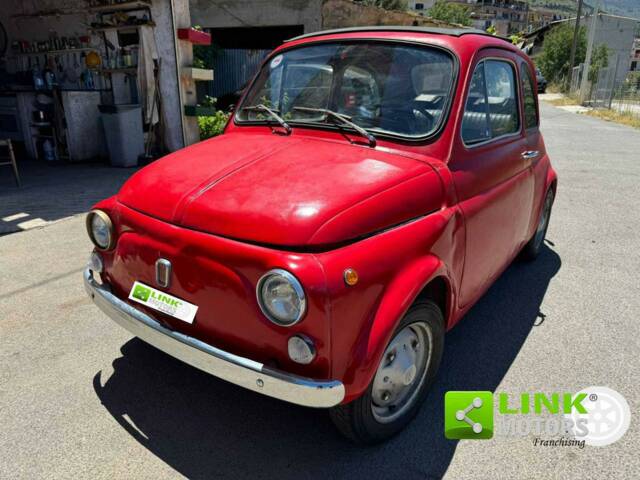FIAT 500 For Sale
The FIAT 500 classic car is one of the most charming microcars in automotive history and has reached cult status since its debut in 1957. Symbolizing Italy's post-war resurgence and mass mobility, the FIAT 500 classic continues to represent driving pleasure and timeless elegance. This article covers the history of the FIAT 500, popular models, important buying considerations, and restoration challenges.
Search results

1973 | FIAT 500 F
REPLICA su base 500 F - VELOCE E DIVERTENTE

1970 | FIAT 500 L
Fiat 500 L Vintage Style By Affari Sbullonati

1969 | FIAT Ghia 500 Jolly
Evocation Jolly Dream

1970 | FIAT 500 F
Fiat 500 F RED



1970 | FIAT 500 L
Fiat 500 L Summer Style

1967 | FIAT 500 F
Edizione Blu Ocean



1971 | FIAT 500 Giardiniera
Autobianchi Gardiniere

1971 | FIAT 500 L
FIAT 500 L

1968 | FIAT 500 F
FIAT 500 0.5 18 CV

1954 | FIAT 500 C Belvedere
FIAT 500C Belvedere anno 1954 targa e libretto originali

1970 | FIAT 500 L
FIAT 500L 110 F Berlina
FIAT 500 Classic Car: History
The FIAT 500 classic car, known as the “Cinquecento”, was designed as a compact city car that was both affordable and practical. Featuring a 479cc twin-cylinder engine and a top speed of about 85 km/h, the FIAT 500 was the perfect urban vehicle in the late 1950s and 1960s. It succeeded the FIAT Topolino, which was Italy's people's car before the war.
Key milestones include the introduction of the FIAT 500 Giardiniera, an extended wagon version that was produced into the 1970s. The sport versions of the FIAT 500, such as the FIAT 500 Abarth, gained fame for performance and sporty features. Altogether, over 3.8 million FIAT 500s were produced, significantly shaping post-war Italy.
Popular FIAT 500 Classic Models
- FIAT Nuova 500 (1957-1960): The initial mass-production model, featuring minimalist design and a small twin-cylinder engine. Commonly found in Italian cities, with a fabric roof and a simple interior.
- FIAT 500 D (1960-1965): This evolution of the Nuova 500 offered practical upgrades like larger windows and a more powerful engine. The characteristic folding roof added unique charm.
- FIAT 500 F (1965-1972): The most produced model in the series, based on the Nuova 500. Its wider track and sturdier build made the 500 F a durable and everyday vehicle.
- FIAT 500 L (1968-1972): The “luxury” edition with a more comfortable interior. An updated dashboard and additional chrome details set new small car design standards.
- FIAT 500 Giardiniera (1960-1977): A wagon version with additional storage space and practical hatchback design. Ideal for families and craftspeople alike for its versatility.
These models demonstrate the evolution of the microcar throughout FIAT 500's production.
Features of the FIAT 500 Classic Car
The FIAT 500 classic car stands out for its iconic design and distinctive silhouette. Despite its small size, it offers a surprisingly enjoyable drive and a sense of freedom, especially the convertible roof models. Its simple mechanics appeal to hobbyists, with many repairs being straightforward. Spare parts remain widely available, easing maintenance.
Key Purchasing Considerations for FIAT 500 Classic Cars
- Rust Issues: The wheel arches, door sills, and floor are especially prone to rust. Carefully examine these areas as rust is a frequent issue with these models.
- Engine Condition: The FIAT 500's twin-cylinder engine is relatively simple but check for leaks and unusual noises which may indicate wear.
- Transmission: Issues with gear shifting are not uncommon. Make sure the car shifts smoothly into all gears.
- Braking System: Many FIAT 500 classics still have the original drum brakes. Ensure they are in good condition or have been modernized.
FIAT 500 Classic Car: Technical Specifications
Below is an overview of the key technical specifications and features of the most popular FIAT 500 classics:
| Model Series | Model Name | Generation | Year | Body Type | Engine | Power |
|---|---|---|---|---|---|---|
| FIAT 500 | Nuova 500 | – | 1957-1960 | Sedan | 479cc Twin-cylinder | 13 HP |
| FIAT 500 | 500 D | – | 1960-1965 | Sedan | 499cc Twin-cylinder | 17 HP |
| FIAT 500 | 500 F | – | 1965-1972 | Sedan | 499cc Twin-cylinder | 18 HP |
| FIAT 500 | 500 L | – | 1968-1972 | Sedan | 499cc Twin-cylinder | 18 HP |
| FIAT 500 | 500 Giardiniera | – | 1960-1977 | Wagon | 499cc | 18 HP |
Restoration of FIAT 500 Classics
Restoring a FIAT 500 classic is generally more straightforward than with many other classic cars, though certain challenges exist. The rust issue is often considerable in old models, especially affecting the body structure and wheel arches, making a thorough inspection essential. Don’t underestimate engine condition. Thanks to its simple technology, many repairs can be done personally.
The use of original parts during restoration is crucial, significantly boosting collectors' value. A broad market for both original and reproduced spare parts exists for FIAT 500 classics, facilitating restoration processes. Successful restorations, particularly of rare models or those with well-preserved bodies, can considerably increase their value, turning the FIAT 500 into a true gem.
Conclusion
The FIAT 500 classic car is not merely a small vehicle; it’s a symbol of Italian post-war era and automotive innovation. Its iconic shape and reliable engineering make the FIAT 500 a genuine collector's item. Be it a well-restored treasure or a project base, Classic Trader offers a vast selection of FIAT 500 classics. Discover now to get your “Cinquecento”!
FAQs about FIAT 500 Classic Cars
Why are FIAT 500 classic cars so popular?
The FIAT 500 embodies the charming Italian lifestyle of the 1950s and 1960s. Its iconic design, compact size, and simple mechanics make it a desirable collector's vehicle. Furthermore, it offers a unique driving experience that perfectly combines nostalgia with driving pleasure.
How can I find spare parts for the classic FIAT 500?
Spare parts for the classic FIAT 500 are still readily available, especially through specialized dealers, online platforms, and classic car clubs. This accessibility and often affordable pricing significantly ease the maintenance of the vehicle, allowing enthusiasts and restorers to find the necessary components without hassle.
What should be considered when buying a classic FIAT 500?
When purchasing a classic FIAT 500, pay particular attention to the condition of the bodywork, especially regarding rust. It's also essential to conduct a thorough inspection of the engine and transmission to ensure both are functioning correctly. Additionally, the braking system should be carefully checked, as it is commonly prone to issues.